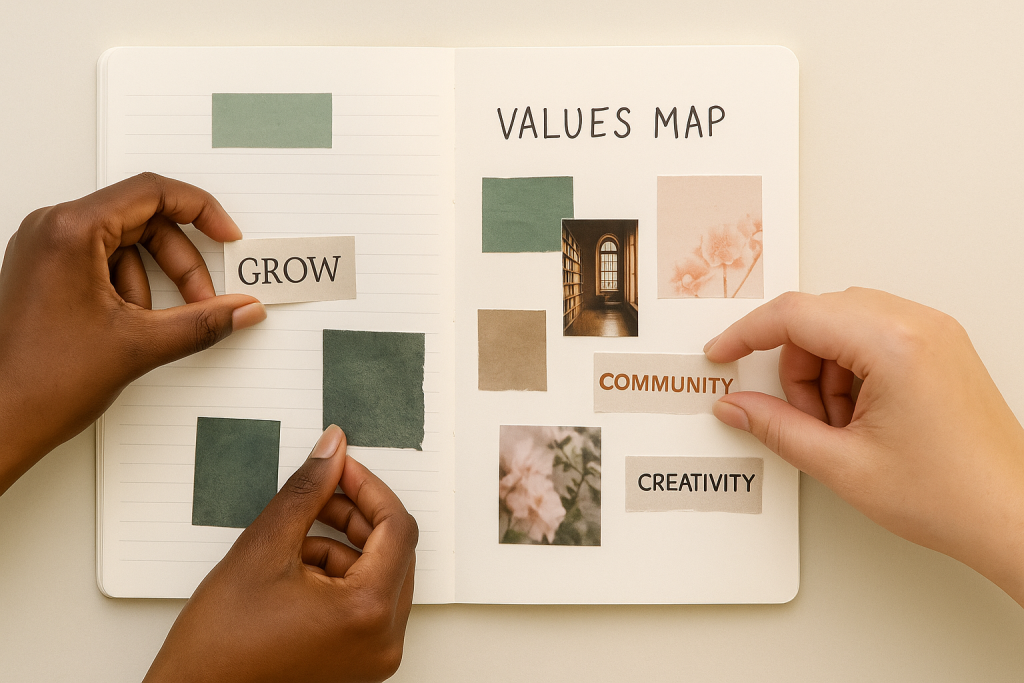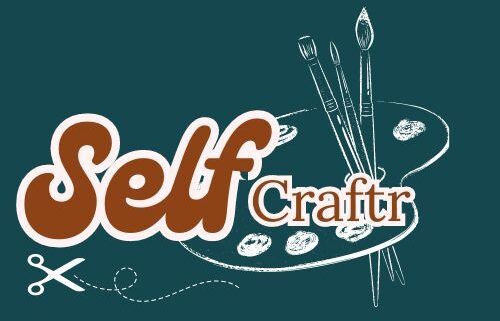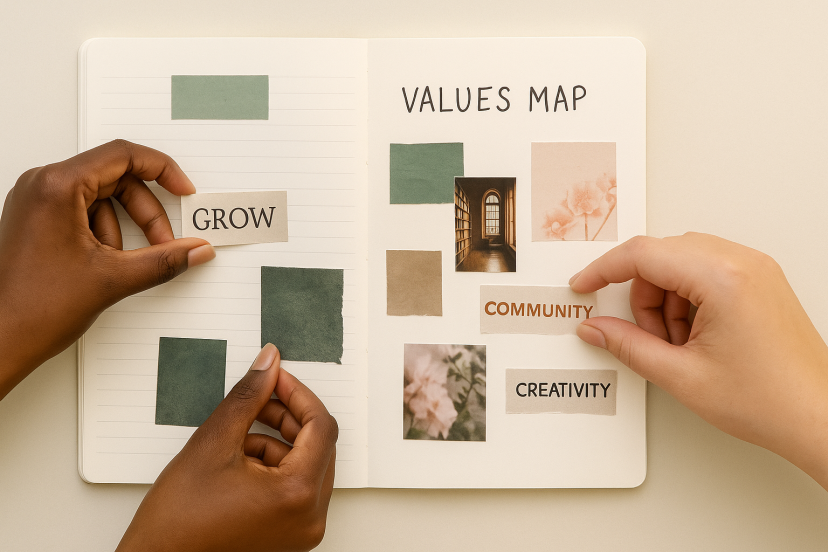5 Vision Board Alternatives: Collage Journal Ideas for Intuitive Clarity
We may earn a commission for purchases made using our links. Please see our disclosure to learn more.
You want the manifest-y magic of a vision board—without a giant poster staring at you from the wall. Enter the collage journal: portable, private, and way more flexible. In this guide, we’ll explore Vision Board Alternatives: Collage Journal Ideas you can start tonight, plus an easy toolkit, product picks, and two research-backed practices to keep your motivation real (not just pretty).
What a Collage Journal Is (and why it works)
Think of it as a vision board in pages: you collage images, words, and textures into a notebook. It’s visual like a board, but it evolves week by week—no more “set it and forget it” syndrome. Collage journaling invites reflection, iteration, and actual next steps, not just mood-board vibes.
Why Look Beyond Traditional Vision Boards
Posters get dusty. Goals change. Collage journals fit your bag and your season of life. You can flip to “Career,” “Wellness,” or “Travel” spreads whenever you want, then layer new images, notes, and to-dos right on top.
Your Starter Kit (simple + affordable)
Grab: a glue runner or stick, scissors, washi tape, a few magazines/printouts, and a sturdy notebook. If affirmations help you focus, tuck in a mini deck—try these affirmation cards to prompt intentional pages and gentle self-talk (they’re lovely as pull-a-card starters each session).
The “Clarity First” Spread
Open with one question per page:
- What do I want to feel?
- What do I want to build?
- What do I need to release?
Collage around your answers, then add one tiny action you’ll take this week.

The “Values Map” Collage (identity anchors)
Choose 4–6 personal values (e.g., family, curiosity, equity, vitality). Build a mini collage quadrant for each. Add 1 behavior that proves each value this month. Rinse, repeat monthly.
The “Storyline” Spread (before → bridge → after)
Left page: images/words of where you are.
Right page: the “after.”
Between them, paste a thin “bridge” strip of images symbolizing habits, skills, or relationships that carry you across. Label the bridge with 3 micro-steps.
Seasonal Vision Pages (gentle, doable)
Create one spread per season (or lunar cycle): colors, textures, and a 3-item “focus list.” When the season shifts, collage a page review—what moved, what stuck, what surprised you.
Micro-Moodboards (5 minutes, tops)
When life’s loud, cut three images, one word, one small note. Done. These tiny wins keep the journal alive in busy seasons.
The “Yes/No” Spread (decision helper)
Split a spread. On the left, collage imagery of “Yes, I’m in.” On the right, collage “Nope, not now.” Notice which side fills up. Add a one-line reason. Close the book. You’ll feel the answer in your body later.
Socially Conscious & Culturally Aware Collaging
Use images that reflect your communities and identities. Seek diverse magazines or printables; include languages or symbols that feel like home. Add pages for mutual-aid goals, community learning, or creative collaborations.

Print-From-Phone Collage (make it personal)
Use a mini photo printer to pull favorite phone pics into your spreads—friends, places, tiny wins. A personal photo next to an affirmation hits differently than a stock image.
The “Obstacle Remix” Page (science-savvy)
Pick one goal. Collage the obstacle boldly (time, childcare, fear). Then collage 2–3 “if-then” cues beside it: If the baby naps, then I’ll draft 100 words. You’re wiring implementation intentions right into your page (more on the research below).
Rituals That Keep It Fun (not homework)
- Set a 15-minute timer.
- Play one song per spread.
- Pull a card at the start (see the affirmation card prompt above).
- End with a date stamp + one doable next step.
Common Mistakes to Avoid
- Only pretty, no plan. Add micro-actions.
- All “future self,” zero “current resources.” Collage what you already have and can leverage.
- Perfectionism. Glue it down. You can collage over it later.
Simple Prompts to Kickstart Tonight
- “More of this / less of that” spread
- “Five places my creativity lives”
- “One habit I’m rehiring”
- “People who refill my cup”
🔹 Product Picks: Tools That Make Collage Journaling Smoother
Below are five Amazon-available tools readers love for collage journaling. I’ve summarized typical praise/complaints so you can pick confidently.
1) HP Sprocket 2×3″ Instant Smartphone Photo Printer
Why it’s great: Prints sticker-backed photos from your phone—instant personal images for your spreads.
Features: Bluetooth; ZINK 2×3” sticky-back paper; compact.
Pros: Fast setup; no ink needed; photos double as stickers.
Cons: Small print size; best in good lighting.
Best for: Personalizing spreads with real life moments, gratitude pages, tiny wins logs.
Review snapshot: Users love its portability and ease of printing from the app; some note color accuracy varies by lighting and paper batch.
2) Fiskars SureCut 12″ Paper Trimmer
Why it’s great: Clean, straight cuts—no more ragged magazine edges.
Features: SureCut wire cut-line; 12″ cut length; swing-out arm; aluminum grid.
Pros: Accurate; sturdy; space-saving.
Cons: Blades need periodic replacement.
Best for: Precision trims, titles, photo borders.
Review snapshot: Consistently praised for accuracy and ease; buyers mention swapping blades keeps it sharp.
3) Free Period Press Collage Kit Vol. 1
Why it’s great: A curated book of tear-out imagery—no need to hunt a dozen magazines.
Features: 120 perforated pages; photos, textures, illustrations.
Pros: Ready-to-use images; high-quality paper.
Cons: Styles may skew “design-y”; supplement with personal photos for diversity.
Best for: Beginners who want quick, cohesive spreads.
Review snapshot: Buyers like the variety and paper weight; note that themes lean modern/minimal.
4) NOGAMOGA 100-Roll Vintage Washi Tape Set
Why it’s great: Instant borders, tabs, and color coding.
Features: 100 rolls; multiple widths (10 mm & 25 mm).
Pros: Huge variety; easy to reposition; matte finish.
Cons: Adhesion is gentle—reinforce on textured paper.
Best for: Layering, labeling, and framing focal images.
Review snapshot: Fans love the quantity/variety; a few wish for stronger tack on rough surfaces.
5) Tombow MONO Permanent Adhesive Applicator (Tape Runner)
Why it’s great: Mess-free gluing—no waves or wrinkles under photos.
Features: Acid-free; refillable; 1/3″ x 472″ adhesive.
Pros: Clean, instant bond; photo-safe.
Cons: Refills add to long-term cost.
Best for: Photo layers, small cutouts, vellum edges.
Review snapshot: Users highlight smooth application and archival safety; occasional notes about learning the right angle for perfect lines.
Quick Comparison
| Model | Key Spec(s) | Warranty* | Approx Price/Tier | Best For |
| HP Sprocket 2×3″ | Bluetooth, ZINK sticker paper | Varies by seller | $$ | Personal photo stickers |
| Fiskars SureCut 12″ | Wire cut-line, swing arm | Varies by seller | $$ | Precise trimming |
| Collage Kit Vol. 1 | 120 perforated pages | N/A (book) | $ | Ready-made images |
| NOGAMOGA Washi 100 | 100 rolls, mixed widths | N/A (consumable) | $ | Borders & tabs |
| Tombow MONO Tape | Acid-free, refillable | Varies by seller | $ | Clean adhesion |
*Always confirm the current warranty/return policy on the product listing.
🧪 Research-Backed Practices You Can Apply in Your Pages
1) Expressive writing can reduce stress/anxiety (small but real effects).
A randomized controlled trial found that structured expressive writing helped reduce test anxiety in students—benefits linked to the use of insight and positive-emotion words. Try finishing each collage with three sentences about what the page means to you and one tiny next action.
2) “MCII” (Mental Contrasting + If-Then Plans) boosts goal follow-through.
A 2021 meta-analysis reported small-to-medium improvements in goal attainment when people paired a vivid future with honest obstacles and specific if-then plans (MCII). Translate this to collage: page the dream on the right, the obstacle on the left, then add three if-then stickers along the bottom. Example: “If it’s 8 pm, then I set a 10-minute tidy timer.”
Nuance matters: some commentators caution that only fantasizing about the “after” can backfire because it may dampen effort. Pair imagery with plans, not just vibes.

A One-Hour Collage Journal Flow (save this)
00:00–05:00 — Ground: pull one affirmation card and write a line about why it resonates.
05:00–20:00 — Cut/paste images for your theme (Values, Seasonal, or Storyline).
20:00–30:00 — Title + washi frame.
30:00–45:00 — Add one obstacle + 2–3 if-then cues.
45:00–55:00 — Expressive writing: three sentences of meaning, one actionable next step.
55:00–60:00 — Date stamp, close the journal, tiny celebration (tea counts).
FAQs
How is a collage journal different from a vision board?
A vision board is typically one poster for a season; a collage journal is many evolving spreads. You’ll iterate faster, reflect more, and carry it with you—so your goals stay alive.
What notebook size works best?
A5 or 7″x10″ hits the sweet spot: portable yet roomy for images. If you print photos, ensure the paper handles mild adhesive without warping.
Do I need fancy supplies?
No. Start with a glue stick/tape runner, scissors, and a magazine. Upgrade later with a trimmer, washi, and a mini photo printer if you love personal pics (see product picks above).
How often should I collage?
Weekly is great; monthly is fine. Aim for consistency over intensity: 15–30 minutes keeps momentum without pressure.
Can collage journaling help mental health?
It’s not a clinical treatment, but expressive writing and art-making are associated with small, meaningful benefits for stress and mood. If you’re struggling, pair creative practices with professional care.
Wrap-Up: Make it real, make it yours
Let your Vision Board Alternatives: Collage Journal Ideas be a living conversation with your future self. Mix images with honest obstacles. Add if-then cues. Write three sentences and pick one step. And remember—progress likes tiny gluey hands. You’ve got this.


